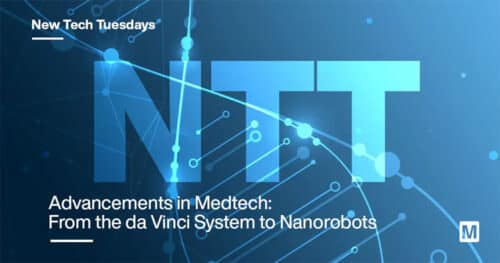Medical technology has been a fascination of mine ever since I was introduced to engineering. I’ve been around medical equipment since I was three years old due to a heart condition, and I used to go into those huge MRI machines not knowing anything about what this technology did. Turns out that it’s a pretty important tool that doctors use to get images inside the body. Not even ten years after the first MRI was taken, the first robotic system was used for a biopsy, thus beginning the history of robotic technology used in medical applications.

Use of Robotics in the Medical Sector
The use of surgical robotics wasn’t approved in the US until 1997, when the Food and Drug Administration (FDA) allowed use of the technology for visualization and extraction purposes—only a fraction of its capabilities. Today, robotics help doctors perform minimally invasive surgeries, which allow patients to recover more quickly with less scarring and reduced risk of infection.
The goal of using robots in surgical applications is complete autonomy. However, this quickly shifted to robotic systems that are controlled by the surgeon. The da Vinci system was the first FDA-approved controllable system used for medical robotics in North America. This system set the surgical robot standard and continues to grow to more than 6,000 units and 8.5 million operations worldwide1. For minimally invasive surgeries, the da Vinci system allows the surgeon to make precise incisions efficiently, effectively, and with fewer risks of error. The da Vinci system also eliminated the need for an assistant in the operating room, as engineers added a third arm equipped with the tools necessary to complete the procedure.
Besides surgical robots, healthcare facilities have also implemented robotic systems such as exoskeletons and delivery robots to help both patients and doctors in their respective activities. Exoskeletons help rehabilitate patients with mobility issues primarily below the waist. Exoskeletons utilize sensors to detect small electrical signals and respond with movement2. At this time, mobile delivery robots have limited uses but currently assist in transporting medication to patients, reminding the patient to take their medicine, and delivering samples to and from the lab.
Looking to the Future with Nanorobots
Nanorobotics is the next step in creating life-changing technology for the medical industry. These microscopic robots will be able to travel and think autonomously to find and fix health issues in the body. These tiny bots can be the size of a human hair and will be able to connect and form any shape necessary for treatment. In terms of the sensors used in these nanorobots, you might say that teamwork makes the dream work, as researchers continue to use biological reactions to target and determine what job needs to be accomplished.
Potential of Nanorobotics In Medicine and More
We aren’t quite at the level of Tony Stark’s nanotechnology, but we are closer than ever. Though the nanorobots won’t be able to generate a full body exoskeleton in seconds, nanorobots will have the ability to find and treat damaged cells anywhere in the body. Ideally, this technology will be used for cancer treatment, as there are very few treatment options currently available. However, these microscopic bots will have many more use cases than just medicine. They could be used as research vessels, allowing engineers and scientists to build or discover microscopic properties that were previously unknown to us. Hopefully, this leads us to a real-life nanotech Ironman suit. That would be awesome.
Featured Product
We’re not quite there yet, but the following product could be an essential step forward. This week’s New Tech Tuesday features the CUI Devices AMT13A Modular Incremental Encoder Kits.
The AMT13A series is an industrial-grade encoder with endless industrial use-cases including robotics. Encoders are used to sense motion and determine the position of a shaft using an LED and recording the interruption of light while in use. Having accurate positioning of motors and avoiding unwanted movement of the robot itself is vital to the success of a robot, especially those used for surgical applications. Featuring a rugged design and compact package, the AMT13A series encoder offers high accuracy at 4096 pulses per revolution (PPR) and a low current draw. The modular incremental encoder kit contains various sizes of shaft adapters and a pre-installed alignment tool to get any project fitted with an encoder.
Takeaway
Medtech is an important and developing industry and robots are increasingly playing a key role in lifesaving procedures. Robotics used in medical applications have been around for over 20 years and the benefits have been nothing short of amazing. Engineers are pioneering the new wave of medicine with the use of robotics in a way we have only seen in movies. Today’s surgical robots provide extreme accuracy and efficiency that has transformed the patient’s experience with smaller incisions, less recovery time, and lower risk of infection. Artificial nanorobots are the next step in the evolution of medical robotics. With the implementation of nanorobots, several medical treatments will become minimally invasive and hopefully be able to cure previously untreatable diseases.
Richie Green is a Mouser intern from San Diego who enjoys music and long walks on the beach. He is set to finish his bachelor’s degree in robotic engineering with a minor in business from Arizona State University in the spring of 2024. At Mouser he has worked alongside the technical marketing team to bring educational content to Mouser’s customers through the lens of a current engineering student.






